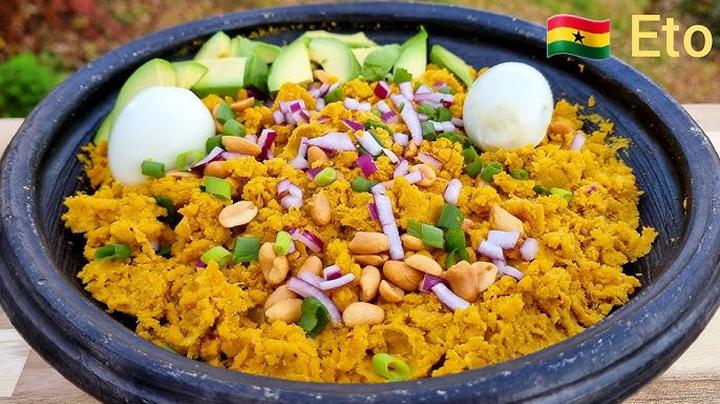Ghanaian cuisine is a vibrant tapestry of flavors, textures, and traditions that reflect the country’s rich cultural heritage. Rooted in local ingredients, communal dining, and centuries-old recipes, these dishes are more than just food—they are a celebration of Ghana’s history, diversity, and spirit. From hearty staples to fiery street snacks, here are 10 Ghanaian dishes that embody the soul of the nation, crafted to showcase their unique place in Ghanaian culture.
1. Egusi
Egusi stew, a beloved dish across West Africa, holds a special place in Ghanaian kitchens. Made from ground melon seeds, this thick, nutty stew is simmered with tomatoes, onions, and peppers, often enriched with palm oil and packed with spinach or bitter leaves. It’s typically paired with staples like fufu or boiled yam, and proteins like fish, goat, or chicken add depth. Egusi represents Ghana’s communal dining culture, where families gather around a shared bowl, dipping and savoring the bold, earthy flavors that tell a story of resourcefulness and tradition.
2. Etor
Etor is a cherished dish, particularly among the Akan people of Ghana, showcasing the versatility of plantains and yams. This mashed delicacy is made by boiling and pounding ripe plantains or yams into a smooth, velvety texture, then blending it with palm oil for a rich, golden hue. Often garnished with roasted peanuts or boiled eggs, etor is both a celebratory dish for special occasions and a comforting everyday meal. Its vibrant color and creamy consistency reflect Ghana’s love for transforming humble ingredients into something extraordinary.
3. Fufu
Fufu is the heartbeat of Ghanaian cuisine, a starchy staple that unites the nation’s diverse ethnic groups. Made by pounding boiled cassava, plantains, or yams into a smooth, elastic dough, fufu is served with soul-warming soups like groundnut (peanut), palm nut, or light soup (a spicy tomato-based broth). Eaten with the hands, fufu is a tactile experience, where diners pinch off a piece, shape it, and dip it into the flavorful broth. Its presence at family gatherings and festivals underscores Ghana’s emphasis on togetherness and shared meals.
4. Jollof Rice
No list of Ghanaian dishes is complete without jollof rice, a fiery, one-pot rice dish that sparks friendly rivalry across West Africa. Ghana’s version is a flavor-packed blend of rice cooked in a rich tomato, pepper, and onion stew, infused with spices like ginger, garlic, and bay leaves. Served with grilled chicken, fish, or vegetables, jollof is a staple at celebrations, from weddings to birthdays. Its bold red hue and smoky undertones embody Ghana’s vibrant, festive spirit, making it a cultural icon that transcends borders.
5. Kelewele
Kelewele is Ghana’s ultimate street-food snack, turning ripe plantains into a spicy, addictive treat. Cubed plantains are marinated in a fiery blend of ginger, cayenne, cloves, and other spices, then deep-fried to a caramelized crisp. The result is a perfect balance of sweet, spicy, and savory, often enjoyed as a late-night bite or side dish. Sold by vendors in bustling markets, kelewele captures Ghana’s lively street culture and knack for transforming simple ingredients into unforgettable flavors.
6. Kenkey
Kenkey, a fermented corn dough dumpling, is a cornerstone of Ga cuisine in southern Ghana. Wrapped in corn husks or banana leaves and boiled, kenkey has a slightly sour, chewy texture that pairs beautifully with spicy pepper sauce, fried fish, or stews. Whether it’s Ga kenkey (smoother and wrapped in corn husks) or Fante kenkey (denser and wrapped in banana leaves), this dish reflects Ghana’s coastal heritage and reliance on maize. It’s a symbol of resilience, as fermentation preserves food in a tropical climate.
7. Konkonte
Konkonte, made from dried and ground cassava, is a humble yet beloved dish, especially in rural Ghana. This brown, porridge-like meal is prepared by stirring cassava flour into boiling water until it forms a smooth, doughy consistency. Often paired with groundnut soup or palm nut stew, konkonte is a testament to Ghana’s resourcefulness, turning affordable staples into nourishing meals. Its earthy flavor and satisfying texture make it a comforting dish that connects Ghanaians to their agricultural roots.
8. Tubaani
Tubaani, also known as steamed bean cakes, is a protein-packed dish popular in northern Ghana. Made from ground black-eyed peas blended with spices and steamed in leaves, tubaani has a soft, fluffy texture similar to a savory pudding. It’s typically served with spicy pepper sauce or shea butter oil, often alongside porridge or as a standalone snack. Tubaani reflects the ingenuity of northern Ghanaian cuisine, where plant-based ingredients shine, and its simplicity makes it a favorite for everyday meals.
9. Tuo Zaafi
Tuo Zaafi, or TZ, is a northern Ghanaian staple that embodies the region’s culinary identity. This thick, stretchy porridge is made from millet, maize, or sorghum flour and served with hearty soups like ayoyo (a green leafy stew) or groundnut soup. Eaten by hand, tuo zaafi is a communal dish that brings people together, reflecting the warmth and hospitality of northern Ghana. Its rustic preparation and bold flavors highlight the region’s reliance on grains and local produce.
10. Wasawasa
Wasawasa is a unique dish made from steamed yam flour, often enjoyed in northern Ghana. Similar in texture to couscous, it’s prepared by steaming coarsely ground yam flour until light and fluffy, then paired with spicy pepper sauce, fried fish, or stew. Wasawasa’s distinct grainy texture and versatility make it a standout, often garnished with shea butter or vegetables for extra flavor. It represents Ghana’s ability to create diverse dishes from staple crops, tying communities to their land and traditions.
